 Your new post is loading...
 Your new post is loading...
Quality storytelling and narrative matter more than ever, and must be first and foremost in your mind when approaching “branded” content. The quotes are intentional. It is an opportune time to drop the word “branded” from that phrase and from your vocabulary. Content is content. Good content is good content. If a story is moving, no one is going to care that it’s brought to you by a brand. Rather, they’re going to be happy the brand brought it to them. And by the same token, content that is annoying is now amplified rather than ignored (because no one can resist a good call-out) and can be more harmful to a brand than ever....
In September of 2013, the late David Carr, skeptical of the burgeoning native advertising tactic that was back then “all the rage,” wrote a column titled “Storytelling Ads May Be Journalism’s New Peril.” Three months later, the Times jumped into the fray. Today the company boasts a fully-fledged content marketing arm, T Brand Studio. Adam Aston, vice president and executive editorial director of the Studio, said when it was first launched, there was a sense of anxiety among the Times’ newsroom, as well as advertisers, that the content they created wouldn’t be up to par with its editorial content. “We were really mindful from inception to approach it as fact-first, narrative-first, with a strong story, strong characters,” he said at a recent panel event, hosted by MediaRadar in New York City, about the future of native advertising. “From inception, whether we were making the simplest stories we could three or four years ago, to today, where a lot of what we’re making is a three-ring circus of interactivity, like VR and AR, we’re still driven by the same thought that the story, the quality of the reporting, finding authentic people, much in the way that our newsroom inspires readers – we want to do the same thing.” Here are five tips from the panelists for using native advertising....
The nonprofit Online Trust Alliance (OTA) on Wednesday conducted a study that found 71% of native ads on top media sites fail to offer adequate labeling, transparency, and complete consumer disclosure.
This is a blow to the native ad/branded content business and should be a wake-up call for publishers and content studios.
The study, an analysis of native ads on the top 100 news websites, found that 71% earned failing scores for disclosures, delineation, and discoverability. The bottom line: The sites didn’t offer consumers the ability to easily discern pure editorial from ads.
As most readers of this column know, native advertising refers to Web site content that’s funded and produced outside the publisher’s editorial review or influence, yet is designed to appear similar to editorial on that site. As the OTA mentions, “this illustrates the tension -- paid for and controlled separately, but presented in a way to appear as editorial. The potential for audience confusion or misinterpretation is obvious, and the rapid rise in the deployment of native has already prompted concerns from advocates, media and regulators.”...
“While the industry looks at native advertising as the holy grail to drive new revenues, they are failing to address the long-term issue. With 71% of native ads failing to pass the consumer transparency acid test, this report should be a wake-up call to the industry. Inaction is not an option. Conversely, providing these concrete examples and recommendations helps advertisers, networks and publishers in moving forward,” Craig Spiezle, executive director at the Online Trust Alliance, told Native Insider via email.
I am super passionate about what I do in the world of telling business and marketing stories. If you read my stuff and know me, you know I am a storytelling nerd from both the business and improv stages—and proudly!
I love that storytelling is experiencing a “corporate Renaissance” across business, social media, social entrepreneurism, and executive communications. Storytelling is so much bigger than marketing. It’s the foundation of how companies communicate who they are in the world and what they stand for. A resurgence is a great thing, and storytelling itself—the original social medium for humans—is evolving in the business world. That is a great thing.
In doing my work, in chatting with fellow story practitioners and branding execs, and in doing research for a book to be published later this year, I’ve stumbled upon what I believe (and am already experiencing) the next wave of storytelling will look like. Much of it involves getting out of the way, empowering others, and thinking bigger.
Here are seven ways to jump on that next wave and reinvigorate your organization’s storytelling for more successful marketing this year....
On Monday, Gucci will release its latest fashion film, a Gia Coppola-directed spin on the tragic Greek love story of Orpheus and Eurydice, set in present-day New York City and starring Lou Doillon, Marcel Castenmiller, Laura Love, Rocco Di Gregorio, among others. Coppola and stylist Arianne Phillips worked in tandem with Alessandro Michele to capture the dreamy feel of the hot-shot creative director’s Pre-Fall 2016 collection, which the film — shot across five locations and broken into four episodes — was created to promote. Michele even designed a custom pink 10-foot long wedding veil for Doillon’s character.
But while shorts like these are nothing new, the genesis of the film was fairly unorthodox. Instead of tapping its internal marketing team or a traditional agency, Gucci worked with 23 Stories, the branded-content studio launched in January 2015 by publishing giant Condé Nast. Beyond Gucci’s own marketing channels, the film will be distributed through six Condé Nast (US) properties — Vogue, GQ, the New Yorker, W, Vanity Fair and Pitchfork — which, together, attracted a total of about 32 million unique visitors in April 2016, according to Comscore. Beyond their URLs, those six publications boast a cumulative social media following of nearly 67 million. The film will also be promoted via Vogue China and Vogue Japan. Gucci and Condé Nast suggest the project is bigger and more ambitious than anything else either party has previously done in the branded-content space, both in terms of the level of talent recruited and also the scale of the production.
To be sure, the Kering-owned Italian luxury house has the resources and capacity to create video content like this on its own. But Gucci is after Condé Nast’s larger, and presumably more diverse, audience. For instance, Gucci has 8.8 million followers on Instagram while these six titles combined have about 18.5 million. In this deal, Pitchfork’s millennial male followers — an important demographic for Gucci under Michele — are as crucial to the equation as W’s affluent luxury consumer....
Like most news publications, the 14 organizations that participated in a recent study of native advertising label the content to distinguish it from their independent editorial content. They said they were well aware of the need to maintain audience trust in the crowded news and information market.
However, in general, the use of the same storytelling conventions and formats as news in sponsored content has prompted user confusion and drawn the attention of the Federal Trade Commission.
The 14 publications that participated in "The Rise of Sponsored Content in Digital News Publications," a study I produced for the Tow-Knight Center for Entrepreneurial Journalism at City University of New York, maintained that native ads done well aren’t necessarily deceptive or even unwelcome. The key they said, is to provide engaging content that is relevant to the audience and to generally avoid making direct sales pitches.
“I don’t think anybody objects to native advertising. People just object to bad advertising,” said Sebastian Tomich, Senior Vice President Advertising & Innovation at The New York Times. “It comes down to quality, user experience and quality.”...
Most online publishers use some form of native advertising — ads that look like news stories — to grow revenue. It is accepted practice to declare that this content is sponsored by a company, so that readers can differentiate between what is and is not news. However, the way in which many publishers declare these ads could be "complicit with deception," according to a new study by Bart Wojdynski, director of the digital media, attention, and cognition lab at the University of Georgia.Wojdynski and Nathaniel J. Evans, assistant professor in advertising at the same university, led the study, which found that 60% of readers did not notice the sponsor disclosure label placed at the top of sponsored articles. It also showed that readers are seven times more likely to recognize the labels that use some form of the words "advertising" or “sponsored,” than those which use more vague phrases like “brand voice” or “presented by.” Overall, only 20% of people in the study were aware that they were reading advertising, rather than objective, editorial content....
It was recently brought to The Drum’s attention that we are longing for long-form. The age of bite sized media is seeing a resurgence of its comfortable long form component, despite our attention spans shrinking into oblivion with a quick fix of 140 characters.
Facebook Instant Articles, the Guardian’s ‘The Long Read’, Snapchat Discover suggests that people are craving more insight into the things they are interested in rather than just flashes of information. The Drum Network asked its members what they thought about the resurgence of longform, and if they thought it was here to stay....
To say native content has grown since last year would be an understatement. In 2014, Pressboard combed through 1,500 pieces of content for our "best of" list -- this year it was closer to 7,000. To give you an idea of how far the space has come, we had to buy VR headsets just to review a couple of the entries.
2015 was the year that native content moved from experimental to fundamental and nearly every major publisher and brand discovered the power of stories, instead of ads. Here are some of the best from the last 12 months...
Social media is having a dramatic, perhaps outsized impact on how digital news is produced, distributed, consumed and ultimately monetized. As mobile and social technologies reach critical mass, it is fueling a footrace to create highly shareable, yet informative news stories that generate traffic. More critically this is changing how journalists approach their craft.
To address this dynamic further, Katie Scrivano and the Edelman Media Network (a team of earned media specialists) teamed with two start-ups,NewsWhip and Muck Rack to study U.S. social news consumption.
Working with NewsWhip, we identified the 50 overall most-shared, English-language articles, and in six key topics – general news, food and beverage, energy, health, technology and finance. Edelman Berland then analyzed each story to identify significant commonalities. This helped shaped a survey of more than 250 working journalists that Edelman conducted in collaboration with Muck Rack....
Eagle-eyed readers may notice a new feature here on Re/code today. It’s called “Sponsor Content,” and is, for us, a new form of advertising. Known broadly as “native advertising,” this is a category of ad that takes the form of an article written by, or commissioned by, an advertiser. It’s widely used online, but the technique actually goes back well before the Web, when print publications ran articles written by advertisers that were called “advertorials.”
Some websites might try to present these ads as if they were normal posts written by their reporters, editors, or curated guest contributors. We won’t be doing that. You’ll notice that we clearly label them “Sponsor Content” with a blue label instead of our usual black one. We also use the company logo next to the writer’s byline, and, at the bottom of each such post, include a disclosure statement saying that the article is a form of advertising, and was neither written by, nor edited by, our journalists.
That doesn’t mean these pieces are bad, or unworthy of your time. It doesn’t mean we are embarrassed to post them. In fact, we hope you will find them interesting. It just means we want to keep faith with you by making things clear.
When readers started moving to the internet, media analysts thought longform journalism was in trouble. Attention spans were going to shrivel. Readers wanted short, they wanted snappy, they wanted 140 characters and not much more (though a listicle on the side couldn’t hurt). Who would want to scroll through an 8,000-word article on an iPhone screen?
A good number of people, as it turned out. Longform has gone digital and is thriving. BuzzFeed has a longform editor, and longform aggregate website Longreads is partnering with The Atlantic. Stories like The New York Times’ “Snow Fall” have blended text with sleek visuals and multimedia.It’s not certain where longform is going, but a conference at Columbia’s Journalism School on Friday attempted to hazard a guess. The Future of Digital Longform, hosted by the school’s Tow Center for Digital Journalism, covered the questions emerging as longform shifts from paper to screen: “Is form following function, or is the medium cannibalizing the message?” “How can you maintain quality control?” And, of course, “How do you make money?”...
Earlier this week, Coca-Cola declared the corporate website dead.
Take one quick look at their new corporate website and I think you will see an example of the future of quality content marketing. They are clearly displaying how the art of storytelling not only can influence our preference for a brand or product, but surely their intent is to also reach a search engine position of respect and power....
|
Polar tested different ad formats including image-based content (graphics, image galleries, and slide shows), article-based content, and video-based content. It tested more than 30 pieces of content, with each type tested by a minimum of 1,000 people via desktop, mobile, and both. Among the findings of the study, conducted in March 2017: --Consumer awareness of a brand increased to 69% after engaging with branded content, while purchase intent was 51%. The study also used a control group with no branding. --Incorporating companion display ads next to branded content improved purchase intent by 17% and didn’t have a negative impact on brand perception --Imagery (infographics, image galleries, and slide shows) performed the best among content formats. And notably, video isn’t always needed to tell the story. However, imagery outperformed articles by 11%. "We found that consumers responded a bit more favorably when there was less obvious branding,” Bella said....
I've lived and breathed and thought about this space every single day, and here's the sad conclusion I've arrived at: digital display advertising doesn't work.
I think it's safe to say that digital display advertising has never lived up to the promise and the hype. Since the very beginning, advertisers have been obsessed with finding ways to get people to click on their ads. They've worked with an array of ad creation platforms and embraced programmatic methods so that the right ads get in front of the right people, and yet the click-through average across all platforms and methodologies is .06 percent.
This means that for every 1,000 times an ad is shown, it is clicked on only .6 times. This means that for the average digital display campaign to get a single click, it needs to be served 1,800 times....
Therefore, content creators and advertisers may find themselves scratching their heads about how to break through the clutter with compelling branded content that attracts an audience and makes them want more. “While there’s no ‘one size fits all’ when it comes to creating impactful branded content, we’ve identified some common themes in our research and content testing that can be used as best practices for making content resonate with audiences,” said Harry Brisson, Director of Lab Research at Nielsen. To better understand how consumers are reacting to this new form of marketing content, Nielsen assessed consumer reactions to more than 100 pieces of branded content and found that a brand’s effectiveness (e.g., how a brand resonates with viewers) is largely affected by the format and environment the message is delivered in. The results of the analysis uncovered three key takeaways that can help brands deliver strong content that resonates with and builds audiences: - Branded content can drive higher brand recall and brand lift than pre-roll - When viewers enjoy content, they view the integrated brands more favorably - Partnering with a publisher can drive ad impact....
Have you been thinking about turning your organization's communications into your version of a metropolitan newspaper newsroom? Here are some examples you should look at.
Native Insider: Part of the challenge with "native" is that each organization has a different understanding of what it is. For the purposes of the research, what is your definition of native advertising?
Wu: In our study, we defined native advertising as sponsored content, which features content that is similar and consistent with publishers’ content and is often consumed by readers like non-sponsored content. I agree that there are also other types of native advertising, such as sponsored social media posts or sponsored hyperlinks. We focused on sponsored content because it is widely adopted by many news organizations, including very reputable ones like The New York Times.
Native Insider: Your research found that when content was identified as native advertising, readers expressed a lower opinion of the media outlet it was published in. However, the reputation of the company being promoted was not affected. Can you elaborate on this finding?
Wu: I think this was one of the most interesting findings in our study. We originally expected that both companies and media outlets would be negatively influenced. However, the media outlet was the only source that was affected. On one hand, this indicates that readers are not surprised by the sponsored content from a company, since similar covert marketing techniques have been utilized before, such as video news releases....
Gupta sees the market evolving in a bifurcated way: premium native vs. programmatic native. He sees premium native as branded content and maintains that programmatic native is much closer to display advertising. While there’s a lot of excitement around programmatic native from the ad tech community, Gupta takes the contrarian view that native is premium content created by publishers -- and publishers alone. That’s in contrast to programmatic native, which is created by advertisers.
Gupta’s purist view is that premium native is focused on quality content and engagement, while programmatic native is focused on getting an audience at the lowest possible price. Further, “Publishers are starting to see that programmatic native is different than programmatic display,” Gupta says. “They’ve seen how programmatic display has eroded the value of their premium display business.”
Gupta says that while some premium publishers work with Outbrain and Taboola, they’re rethinking working with these partners because of a poor user experience and click bait. In addition, he says that programmatic native doesn’t offer a way to optimize for engagement. Gupta argues that if you’re a marketer and you buy ads on Outbrain and Sharethrough, you don’t know where those ads are going to run....
The underlying reason? Today’s shoppers are skeptic of pure play tactics. They see value in connecting and acquiring rather than reliance on a brand’s library of products. As a result, they are looking for shopping destinations or inspirational sites.
Perhaps that’s why brands are agog over social commerce.
For those unaware, it is the concept of utilizing social networks to increase sales transactions. Actionable marketing expert Heidi Cohen defines it as the maturation and evolution of social media meets shopping....
Therein lies the problem: native advertising is more effective because it masquerades as actual content. But it’s illegal to pass advertising messages off as editorial content. The Advertising Standards Authority in the United Kingdom, for instance, banned a native YouTube ad sponsored by Oreo that featured two well known video bloggers because the agency felt it was not clearly identified as marketing communication.
Stateside, the Federal Trade Commission (“FTC”) has long waged war on false advertising—marketing or advertising communications that tend to mislead consumers. Recently, the FTC issued an “enforcement policy statement on deceptively formatted advertisements” giving advertisers and publishers alike a heads up: deceptive native ads will not be tolerated.
So how can your brand capitalize on native advertising without breaking the law? The FTC offers some insight in their guide, “Native Advertising: A Guide for Businesses.”...
Have you ever wondered if content authenticity is compromised when brands pay influencers for posts?
Finding out how consumers engage with sponsored content isn’t something that marketers should guess on so GroupHigh surveyed thousands of influencers to find out how they prefer to be compensated for their brand recommendations and how their audience feels about sponsored content....
Those 11 inspiring videos are all original feel-good New York Times productions, and as Digiday’s Lucia Moses noted this morning, the ad is intended to drive subscription signups forThe Times, with a prominent call to action at the top of the piece imploring readers to “Get with The Times.
”While this may seem bizarre and a little too meta for this early in the morning, it’s actually a shrewd move by The Times to grow their audience. Clearly, they’ve identified Mashable readers as potential Times readers and subscribers, and as a result, they’ve come to them with a month-long campaign of branded posts._
The Times also punched up the titles of the individual videos for a Mashable audience. “Tattoo Artist Gives Breast Cancer Survivors Nipples and Hope” was originally titled “The Nipple Artist,” and “Can Your Grandma Pump Iron Like This?” was called “Shirley and the Bodybuilder.”...
...As the traditional journalism business continues to implode, journalism educators need to be thinking a lot more about the second category, but also in broader ways about the first. If we recognize journalism in places where we never used to acknowledge its existence, journalism programs will discover niches that could fuel new programs and attract new students.
Here’s one: In 2009, I suggested that some advocacy organizations were creating “almost-journalism” — doing deep and valuable reporting on issues that mattered, such as civil liberties, human rights and more. They could do even better, I said, if they applied basic journalistic principles — because they’d be even more credible.
In the startup world, we hear a lot of talk about the Web and digital media “disrupting” traditional business models in a positive sense. But one rather important old-school industry, journalism, has found its lot in the digital frontier to be a pretty unhappy one. Newspaper subscription rates have plummeted, and only a select few publications have managed to successfully monetize their online content.
Many people have proclaimed multimedia to be the solution to this issue. The logic is that, if you could seamlessly integrate beautiful photographs, graphics, audio and even video into your articles, then you’d have yourself a truly viable product for digital natives.So it became a design problem. And, in late December of 2012, The New York Times may have solved it...
|



 Your new post is loading...
Your new post is loading...



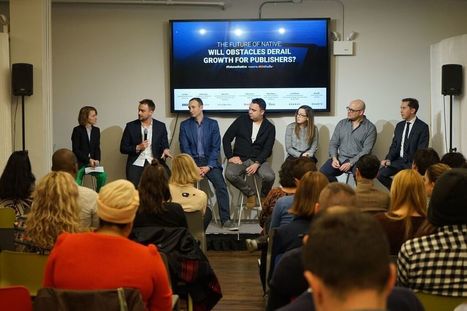
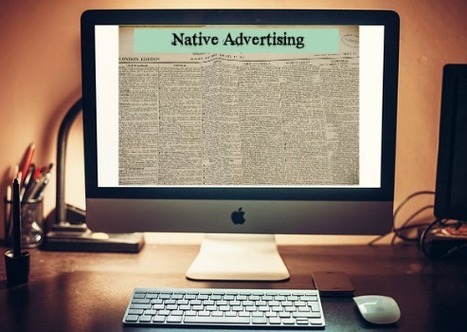
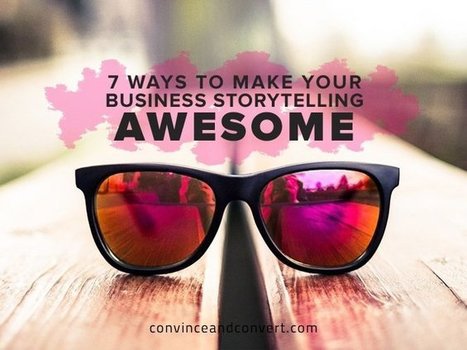
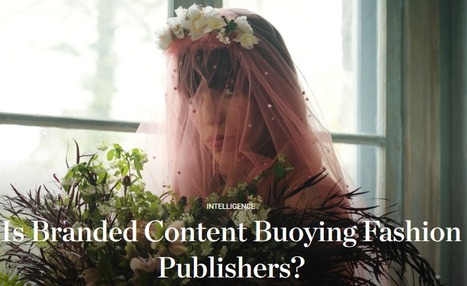





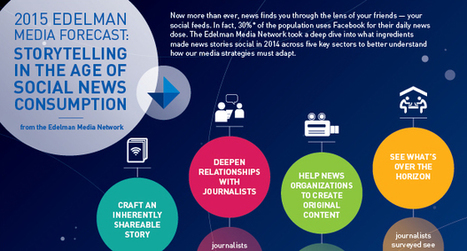















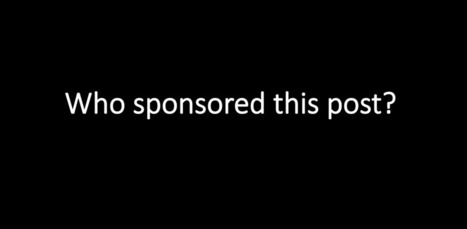
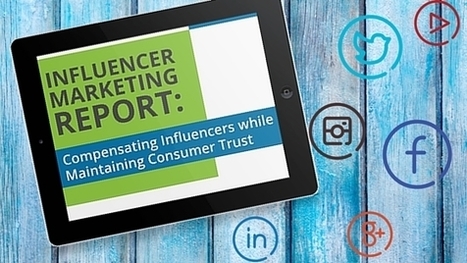
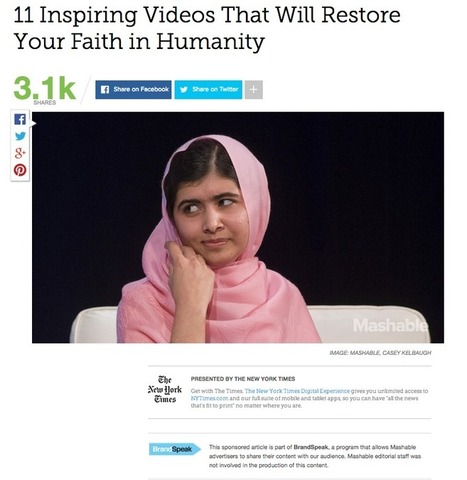







If a story is moving, no one is going to care that it’s brought to you by a brand—they’re going to be happy the brand brought it to them.